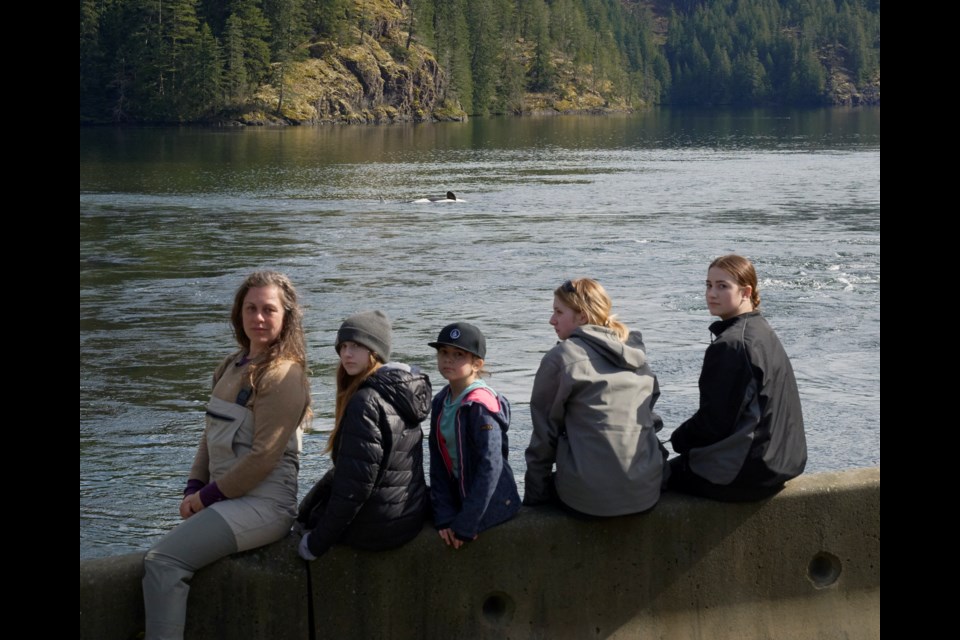Many have been following the plight of a young killer whale who lost its mother when she became stranded in the shallow waters of Zebellos on northern Vancouver Island. Sechelt’s Tom McPherson and his family had front row seats as the events began to unfold.
McPherson, the director of Seaforth Expeditions, was part of the filmmaking team that took home multiple Emmy awards for their three-part documentary series about Vancouver Island’s sea wolves. He’s used to working up close with wild animals in their natural habitat.
As chance would have it, McPherson had recently wrapped up herring tours. McPherson, his daughters Poppy, Lucy and Evvy, friend Elyjah Daigle and Gem Salsberg were camping in the area for spring break when the call for help came over the radio.
The 15-year-old female orca, who had a seal in her mouth, is thought to have been hunting in the channel when she beached on a gravel bar. On March 23, folks in the area tried to roll the whale from her side onto her underbelly in order to keep her blowhole above incoming water.
Immediately, the McPhersons and their crew jumped into action. “We just grabbed as many tarps and buckets as we could and raced over there to try to lend a hand,” McPherson said. “I knew it was going to be a time-sensitive thing, so we were going as fast as I could.”
But by the time they arrived, the mother whale was already dead. It was disappointing to get there too late. McPherson later learned of the extensive effort First Nations members had contributed. The group stayed the better part of the day to see if their boat might be useful. The orca calf was swimming around, and they waited to see if there would be an opportunity to coax it into deeper water.
Since its mother’s death, the two-year-old calf has swam further into the lagoon and been separated from its pod. Both whales are believed to be members of the T pod of transient orcas known as Bigg’s killer whales. A necropsy later revealed the mother whale was pregnant.
For more than a week, members of the Ehattesaht/Chinehkint and Nuchatlaht First Nations, scientists, researchers and Fisheries and Oceans Canada (DFO) have been trying to reunite the baby with its pod. The tides pose a challenge: there is a 30-minute window for the calf to swim out of the area at high tide. The rescue team is considering their options. They’ve tried using the recorded sounds of orcas, corralling the baby and, on April 1, announced they are turning to artificial intelligence to scan photographs of killer whales in order to find the T pod. If the calf doesn’t leave the area on its own, they may hoist it by sling into the open ocean.
Because of his job’s intimate connection with nature, McPherson tries to take his daughters on wilderness trips often, especially to see the megafauna on the coast of B.C.
“In the moment, I certainly saw this amazing opportunity for my kids to potentially be involved in the rescue of an orca,” McPherson said. They watched as the calf swam in the pool. As it raised its head above the water, they could hear its cries. “I could see in my daughters’ faces that they were visibly kind of upset and shaken by the experience. We decided to just stay as long as we could to see if there was any assistance that we could lend.”
Over the years, McPherson has shared his experiences of animal intelligence with his daughters. More than a week after this encounter, it strikes him that the calf is still near its mother. “They have such strong family bonds. It’s pretty incredible to witness that in nature and to see the First Nations’s side of things and how they relate to the orcas,” McPherson said. “I think it’s a pretty interesting lesson for all of us.”
For the McPherson family, it’s a spring break that will be remembered for a long time to come.
With files from Darren Kloster /Times Colonist




